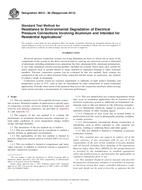Potrebujeme váš súhlas na využitie jednotlivých dát, aby sa vám okrem iného mohli ukazovať informácie týkajúce sa vašich záujmov. Súhlas udelíte kliknutím na tlačidlo „OK“.
ASTM B812-96(2013)
Standard Test Method for Resistance to Environmental Degradation of Electrical Pressure Connections Involving Aluminum and Intended for Residential Applications
Automaticky preložený názov:
Štandardná skúšobná metóda pre odolnosť proti environmentálnej degradácii elektrických Tlakové pripojenie Zapojenie hliníka a je určená pre obytné aplikácie
NORMA vydaná dňa 1.8.2013
Informácie o norme:
Označenie normy: ASTM B812-96(2013)
Poznámka: NEPLATNÁ
Dátum vydania normy: 1.8.2013
Kód tovaru: NS-8240
Počet strán: 11
Približná hmotnosť: 33 g (0.07 libier)
Krajina: Americká technická norma
Kategória: Technické normy ASTM
Kategórie - podobné normy:
Anotácia textu normy ASTM B812-96(2013) :
Keywords:
aluminum, aluminum connections, contacts, environmental testing, humidity testing, mixed environmental testing, mixed stress testing, neutral bar, pressure connection, stress testing, thermal cycling, twist-on connector, ICS Number Code 29.120.20 (Connecting devices)
Doplňujúce informácie
| Significance and Use | ||
|
5.1 The principal underlying the test is the sensitivity of the electrical contact interface to temperature and humidity cycling that electrical pressure connection systems experience as a result of usage and installation environment. The temperature cycling may cause micromotion at the mating electrical contact surfaces which can expose fresh metal to the local ambient atmosphere. The humidity exposure is known to facilitate corrosion on freshly exposed metal surfaces. Thus, for those connection systems that do not maintain stable metal-to-metal contact surfaces under the condition of thermal cycling and humidity exposure, repeated sequences of these exposures lead to degradation of the contacting surface indicated by potential drop increase. 5.2 The test is of short duration relative to the expected life of connections in residential usage. Stability of connection resistance implies resistance to deterioration due to environmental conditions encountered in residential service. Increasing connection resistance as a result of the test exposure indicates deterioration of electrical contact interfaces. Assurance of long term reliability and safety of connection types that deteriorate requires further evaluation for specific specified environments and applications. 5.3 Use—It is recommended that this test method be used in one of two ways. First, it may be used to evaluate and report the performance of a particular connection system. For such use, it is appropriate to report the results in a summary (or tabular) format such as shown in Section |
Duration, weeks |
Maximum Potential Drop Increase, mV |
|
1. |
52 |
0 |
|
2. |
16 |
0.2 |
|
3. |
4 |
1.0 |
1.1 This test method covers all residential pressure connection systems. Detailed examples of application to specific types of connection systems, set-screw neutral bus connectors and twist-on wire-splicing connectors, are provided in 1.2 The purpose of this test method is to evaluate the performance of residential electrical pressure connection systems under conditions of cyclic temperature change (within rating) and high humidity.
1.3 The limitations of the test method are as follows:
1.3.1 This test method shall not be considered to confirm a specific lifetime in application environments.
1.3.2 The applicability of this test method is limited to pressure connection systems rated at or below 600 V d-c or a-c RMS.
1.3.3 This test method is limited to temperature and water vapor exposure in addition to electrical current as required to measure connection resistance.
1.3.4 This test method does not evaluate degradation which may occur in residential applications due to exposure of the electrical connection system to additional environmental constituents such as (but not limited to) the following examples:
1.3.4.1 Household chemicals (liquid or gaseous) such as ammonia, bleach, or other cleaning agents.
1.3.4.2 Chemicals as may occur due to normal hobby or professional activities such as photography, painting, sculpture, or similar activities.
1.3.4.3 Environments encountered during construction or remodeling such as direct exposure to rain, uncured wet concrete, welding or soldering fluxes and other agents.
1.3.5 This test method is limited to evaluation of pressure connection systems.
1.4 This standard does not purport to address all of the safety concerns, if any, associated with its use. It is the responsibility of the user of this standard to become familiar with all hazards including those identified in the appropriate Material Safety Data Sheet (MSDS) for this product/material as provided by the manufacturer, to establish appropriate safety and health practices, and determine the applicability of regulatory limitations prior to use.
1.5 This standard should be used to measure and describe the properties of materials, products, or assemblies in response to electrical current flow under controlled laboratory conditions and should not be used to describe or appraise the fire hazard or fire risk of materials, products, or assemblies under actual installation conditions or under actual fire conditions. However, results of this test may be used as elements of a fire risk assessment which takes into account all of the factors which are pertinent to an assessment of the fire hazard of a particular end use.
|
UL486C |
Standard for Splicing Wire Connectors |
|
ANSI/NFPA 70 |
National Electric Code Available from National Fire Protection Association (NFPA), 1 Batterymarch Park, Quincy, MA 02169-7471, http://www.nfpa.org. |
|
UL486B |
Standard for Wire Connectors For Use With Aluminum Conductors, ANSI/UL 486B Available from Underwriters Laboratories (UL), 333 Pfingsten Rd., Northbrook, IL 60062-2096, http://www.ul.com. |
|
Standard Terminology Relating to Electrical Contacts and Their Use |




 Cookies
Cookies
